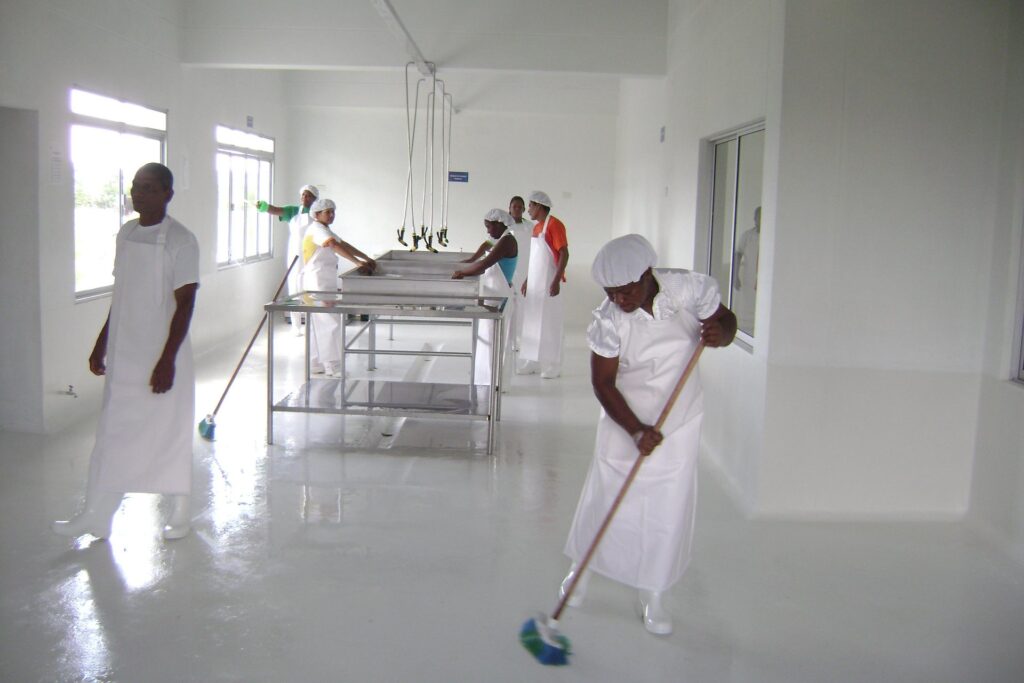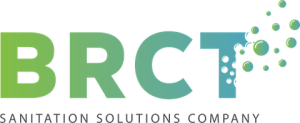According to a report published by the local government, “Out of Compliance” percentages for contaminated equipment were high for facilities observed as part of a study to determine foodborne illness risk factors. Specifically, improper cleaning and sanitization of food-contact surfaces before use were commonly seen, with Out of Compliance values ranging from 25% in schools to 58% in small supermarkets. These 2004 data are consistent with previous findings, indicating that proper implementation of cleaning and sanitization methods needs to be better emphasized during inspections and training programs.

Cleaning
Cleaning is a prerequisite for effective sanitization. Cleaning is the removal of organic matter, using appropriate detergent chemicals under recommended conditions. Organic matter from food residues such as oils, grease and protein not only harbours bacteria but can prevent sanitizers from coming into physical contact with the surface to be sanitized. Besides, the presence of organic matter can inactivate or reduce the effectiveness of some types of sanitizers, making sanitization ineffective.
For cleaning to be performed correctly, the right cleaning agents must be selected for the job. Cleaning agents commonly used include the following:
• Detergents contain surfactants to reduce surface tension between food dirt and the surface so the detergent can penetrate quickly and lift off the dirt from the surface.
• Solvent cleaners contain a grease-dissolving agent that can be used in areas with burned-on grease.
• Acid cleaners are used on mineral deposits that alkaline detergents cannot remove.
• Abrasive cleaners are used to remove heavy accumulations of soil often found in small areas. The abrasive action is provided by tiny mineral or metal particles, such as fine steel wool, copper or even nylon.
Sanitizing
Sanitization follows the cleaning. Sanitization is the application of heat or chemicals to a properly cleaned (and thoroughly rinsed) food-contact surface, producing a 99.999% reduction of representative pathogenic microorganisms of public health importance. Sanitization is not sterilization. Sterilization is the process of destroying all living microorganisms, not just pathogens. Other terms (and their definitions) that are sometimes confused with sanitization and that should be noted are the following:
• Antiseptic—used against sepsis or putrefaction in humans or animals.
• Disinfectant/Germicide—applied to inanimate objects to destroy all vegetative cells, not spores.
• Bactericide—kills a specific group of microorganisms.
• Bacteriostat—prevents the growth of a specific group of microorganisms but does not necessarily kill them.
The two sanitization methods commonly used in retail/food service establishments are heat and chemicals. Their application standards, as defined in the 2009 Food Code, are as follows:
• Heat. In dish machines, the temperature of the fresh hot-water sanitizing rinse as it enters the manifold cannot be more than 90 °C, less than 74 °C in a stationary rack, single-temperature machine or less than 82 °C in all other high-temperature dishwashers. In three-compartment sinks, the water temperature must be at least 77 °C.
• Chemicals. Chemicals approved as sanitizers for food-contact surfaces in retail/food service establishments are chlorine, iodine and quaternary ammonium.
Factors that influence the efficacy of chemical sanitizers to include the following:
• Concentration. Too little will result in an inadequate reduction of microorganisms; too much can be toxic, corrosive to equipment and can lead to less cleanability over time.
• Temperature. Sanitizers generally work best between 13 °C and 49 °C.
• Contact time. To clean microorganisms, cleaned items must be in contact with the sanitizer for the manufacturer-recommended time.
• The presence and nature of the organic or inorganic inactivators on the surface. Some of these are present in detergent residue or soil from an improperly cleaned surface and might react with sanitizers. Thus, it is essential to wash and rinse before sanitization properly.
• The nature of the material surface. Sanitizers react differently with plastic, glass, metal and wood.
• The surface area, topography and geometry of the surface. A rough surface will be more difficult to sanitize than will a smooth surface.
• The nature and species of any residual microorganisms on the surface. The microbial load can affect sanitizer activity.
• Type of microorganisms present. Spores are more resistant than vegetative cells. Gram-positive bacteria are known to respond differently from Gram-negative bacteria when exposed to sanitizers. Sanitizers also vary in their effectiveness against yeasts, molds, fungi and viruses.
Also, testing devices must be used to measure the concentration of chemical sanitizing solutions because: (1) the use of chemical sanitizers requires minimum concentrations of the sanitizer during the final rinse step to ensure sanitization and (2) too much sanitizer in the final rinse water could be toxic. To accurately test the strength of a sanitizing solution, one must first determine which chemical is being used—chlorine, iodine or quaternary ammonium. The appropriate test kit must then be used to measure concentration.
Chemical sanitizers are registered for use on food-contact surfaces through the U.S. Environmental Protection Agency (EPA). Prior to approval and registration, the EPA reviews efficacy and safety data as well as product labelling information. At present, the effectiveness of chemical sanitizers used in retail/food service establishments is determined using one of two methods: (1) the AOAC Germicidal and Detergent Sanitizers Method against Escherichia coli ATCC 11229 for quaternary ammonium compounds, chlorinated trisodium phosphate and anionic detergent-acid formulations or (2) the AOAC Available Chlorine Germicidal Equivalent Concentration Test against Salmonella typhi ATCC 6539 for iodophors, mixed halides and chlorine-bearing chemicals. The FDA is involved in evaluating residues from sanitizer use that might enter the food supply. Thus, a sanitizing agent and its maximum usage level for direct use on food-contact surfaces must be approved by the FDA.
Public concern about the environmental impact of chemicals has to lead to the development of other sanitization methods that have the potential for use in retail/food service establishments.
• Ozone. The ozone molecule (O3) is an antibacterial agent that is very effective at oxidizing and destroying organic and other compounds on equipment and surfaces. As of June 2001, ozone was approved by the FDA as an additive to kill foodborne pathogens. Because it is a gas, ozone leaves no toxic residues on treated surfaces. However, it could be corrosive to various surfaces at high concentrations, and care must be exercised during its generation because overexposure can result in bodily injury.
• Peracetic acid (PAA). An organic acid, PAA, is produced by the reaction of acetic acid with hydrogen peroxide. In the retail/foodservice industry, it has been promoted as a potential chlorine replacement that can be used at a concentration of 150 to 200 ppm on food-contact surfaces. At this concentration, it is capable of killing microorganisms in addition to removing deposits of milk stone and hard-water scales, suppressing odours and stripping biofilms from food-contact surfaces. PAA is not very effective against bacterial spores, and it may be more expensive when compared with other sanitizers.
• Electrolyzed water. Electrolyzed water is a good sanitization method because it has antimicrobial properties, is not corrosive to skin, mucous membranes or organic material, is safe to handle and has little adverse effect on the environment. Electrolyzed water shows effectiveness against a wide range of microorganisms. It can be produced easily using common salt and an apparatus connected to a power source. Because the size of the machine is quite small, electrolyzed water can be manufactured on-site. Although its cost is low, electrolyzed water can be corrosive to certain metal surfaces.
While heat and chemicals are currently the most commonly used sanitization methods, other new methods—such as ozone, PAA and electrolyzed water—show great promise for use in the retail/food service environment. The bottom line is “Don’t compromise—clean and sanitize.”
Recent Posts
Could the standard of cleaning you are receiving be improved?
If you are not happy with your current cleaning contractor's service, don't just put up with it. Get yourself a company who will go the extra mile! Contact us now to help bring the standard of...
COVID-SECURE Disinfection cleaning & fogging services - Johannesburg. Fogging is a quick way to disinfect large areas and allow them to be returned to everyday use. We use a fogger machine...

